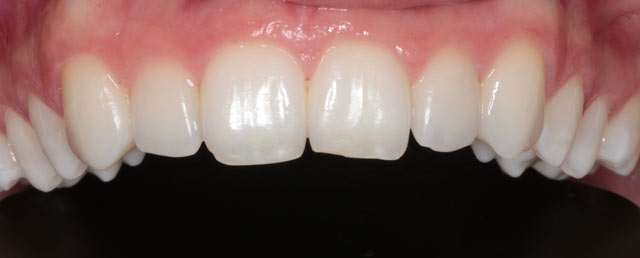Dr Finn André Hammer: orthodontic case study and the importance of communication
Dr Finn André Hammer, a dentist from Norway, shares a recent orthodontic case that demonstrates the importance of constant communication with the patient for a truly collaborative approach to treatment.
A 21-year-old female patient presented to the practice for the first time, enquiring about possible improvements to her smile. She was most concerned about the uneven upper anterior teeth and buccal standing of the upper canines. A friend of hers had received treatment with the Inman Aligner and achieved a good result, so she was interested in finding out whether she too would be suitable.

Assessment

A full dental and medical history were taken, showing no relevant abnormalities or causes for concern. A comprehensive intra and extra oral examination followed (Table 1). An average biotype was recorded and the patient demonstrated good oral hygiene with no periodontal issues.

The upper gingival margin was uneven, which was contributing to the uneven appearance of the teeth.

The patient rejected fixed, comprehensive upper and lower orthodontics due to the aesthetics of the appliance and prolonged treatment time. We therefore discussed the possibility of removable aligners to achieve as close to the desired outcome as possible.
It was explained to the patient that some compromises may need to be made if this course of treatment was selected (Table 2). All the benefits and limitations of fixed and removable orthodontic options were discussed with the patient to ensure informed consent.
Treatment planning
It was suggested to proceed with an upper Inman Aligner to initially align the UR2-UL2, and ClearSmile Aligners to align the canines. Radiographs were taken to ensure no pathology, followed by upper and lower impressions and a bite index, ready to be sent to the IAS laboratory.

A Spacewize+™ digital crowding calculation was also performed to confirm suitability of this case for the appliances, which estimated that 1.2mm of space would need to be created with interproximal reduction (IPR).
Treatment provision
The IPR was performed progressively throughout the treatment process, with more on the left side in order to improve the centreline deviation and encourage the UR2 to push the medial incisor corner to the left also.

After 10 weeks of treatment with the Inman Aligner, the UR2-UL2 were aligned as desired. However, the canines were still in a buccal position and rotated disto-bucally. The patient decided to proceed with the ClearSmile Aligners, as previously discussed, in order to align and de-rotate the upper canines.
New impressions were taken and sent to the IAS laboratory for the ClearSmile Aligners – the patient wore her Inman Aligner in the meantime as a retainer. A force-driver was placed on the UL3 before the first of three ClearSmile Aligners was fitted.

Upon achieving the desired tooth alignment, the patient wished to continue onto tooth whitening and edge bonding, as per the ABB (Align, Bleach and Bond) concept. Impressions were taken for both upper and lower bleaching trays. The planned final tooth shapes after edge bonding were blocked out on the stone model before the trays were fabricated.

The patient agreed to composite bonding on the UR2 and UL1 – it was also recommended for the upper canines and UL2, but she declined.
Whitening commenced with two weeks of at-home treatment using White Dental Beauty 10% carbamide peroxide at night. Two weeks was allowed for the colour to settle and all the H2O2 to disappear from the tooth to enable good composite adhesive. Composite edge bonding was then performed on the UR2 and UL1, using Tif Qureshi’s ‘reverse triangle technique’ and Venus Diamond in shades OM and A1.

Outcome
The patient was very happy with the result achieved in this case, even though it was a compromised treatment. She fully understood and accepted the compromises, which managed her expectations and ensured her satisfaction. We treated the areas she was most concerned about and were able to achieve a straight vertical centreline.

This case highlights the importance of communicating with the patient throughout treatment and seeking their consent to move onto each stage. Some patients will be more or less worried about certain aspects of their smile, so they can decide what adjunctive procedures they’d like and when treatment is finished. It promotes a truly collaborative approach.
Author:

After meeting Tif Qureshi in 2011, Finn became interested in simple orthodontic treatment and certified for Inman Aligner in 2011, ClearSmile Aligner in 2015 and ClearSmile Brace in 2018.
He has done many hundreds of cases based on the ABB philosophy and he has been the lead clinic trainer and mentor for Inman Aligner and ClearSmile Aligner Lite in Norway since 2016. Finn has a special interest for aesthetic composite build-ups and lectures on composite techniques to GDPs and candidates at the University in Oslo.
For more information on upcoming IAS Academy training courses, including those for the Inman Aligner and Aligner system, please visit www.iasortho.com or call 01932 336470 (Press 1)





















